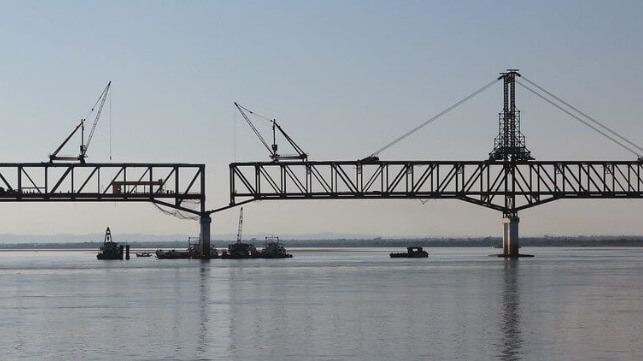China’s Access to the Indian Ocean Via Myanmar is Almost Complete

China has spent over a trillion dollars in hopes that its Belt and Road Initiative would expand its influence across Asia, Africa and Latin America. Unfortunately, deals worth tens of billions of dollars have turned sour, with multiple countries defaulting on Chinese loans amidst a tough global economic environment, and Beijing is looking to restructure the program.
“The international environment for Belt and Road Initiative (BRI) is becoming increasingly complex and there is need to strengthen risk controls and expend cooperation,” Chinese President Xi Jinping told a meeting of senior officials last November.
However, as China has been pondering ways to rework the BRI in countries experiencing financial distress, the same cannot be said of Chinese financial commitment to Myanmar.
Despite Myanmar’s political strife after a military coup in February 2021, China continues to fill an immense economic gap left as many western benefactors fled. But it is not all about Chinese benevolence to Myanmar.
In Myanmar, China sees an opportunity for direct access to the Indian Ocean, significantly expanding its sea power beyond its influence in the Pacific region. Consistent with China’s maritime strategy, the Indian Ocean is highlighted as a fulcrum in cementing China’s sea power.
Partly, this ambition is anchored on China’s bilateral partnership with Myanmar. In 2018, China signed an MoU with Myanmar to establish the China-Myanmar Economic Corridor (CMEC). On January 2020, during a two-day visit by President Xi Jinping in Myanmar, 33 projects were identified to operationalize CMEC. This included development of Kyaukpyu Port and Special economic zone, Myanmar’s first deep-sea port in Rakhine State.
But what comprises CMEC? The CMEC is a 1700-kilometer, inverted y-shape corridor featuring strategic assets including roads, railways and ports, which are expected to connect Kunming in Yunnan Province to Myanmar’s Yangon and Kyaukphyu.
One of the notable signs of progress on CMEC is in development of the Kyaukphyu Deep Sea Port. In February this year, Chinese conglomerate CITIC, the port’s developer, announced the environmental and social impact assessment (ESIA) for the port had begun. The assessment will be completed in 2023, after which the construction will commence.
In addition, a railway line connecting Southwest China’s Chongqing Municipality to Mandalay, southern Myanmar, officially started operation in May, according to a report by China’s Community Party-affiliated Global Times newspaper.
The first trial train departed Chongqing loaded with 60 TEU of electronics, auto parts and other goods, destined to Mandalay, Myanmar’s second-largest city. The total route is 2,000 kilometers starting from Chongqing, passing Lincang and the Mengding-Chinshwehaw border gate to Mandalay. The successful operation of the route should help reduce shipping time for goods coming from inland western part of China to many ports in the Middle East and Europe.
Ultimately, two branch railway lines are scheduled to connect Mandalay to Yangon and Kyaukphyu. The project has been partly achieved with the operation of another railway line stretching from Chengdu, the capital of Sichuan Province, to Lincang, a Chinese city bordering Chinshwehaw, a trade border town in northeastern Myanmar. The railway line was launched last year in August.
During the launch period in August, a shipping trial was conducted with the first cargo transported by sea from Singapore to Yangon, then by truck to Lincang, and finally by train to Chengdu.
All these projects will effectively enable some Chinese shipments to avoid the congested Malacca Strait in their voyage to Middle East and Europe. It is for this reason that CMEC is an important component of Belt and Road Initiative, while also opening the landlocked western parts of China to international trade.
Top image: The Pakokku Bridge over the Irrawaddy (Carsten ten Brink / CC BY NC ND 2.0)
The opinions expressed herein are the author's and not necessarily those of The Maritime Executive.
